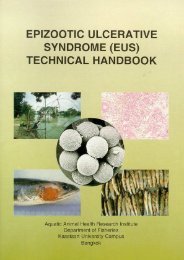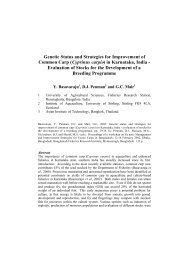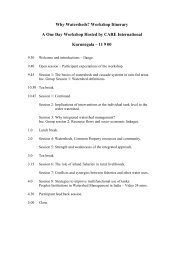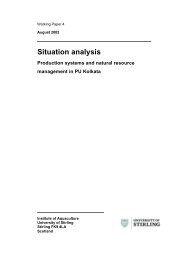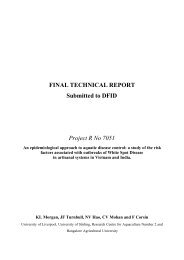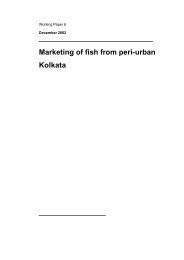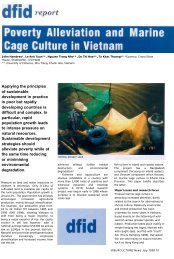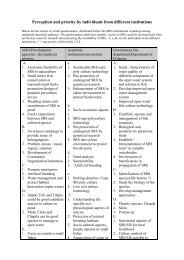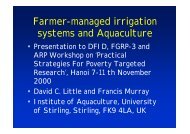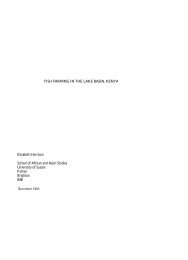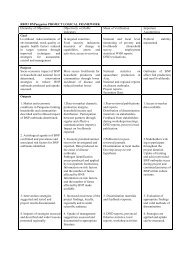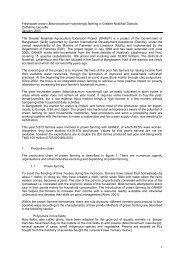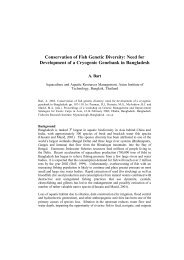NRSP R7872: Renewable natural resource-use in livelihoods at the ...
NRSP R7872: Renewable natural resource-use in livelihoods at the ...
NRSP R7872: Renewable natural resource-use in livelihoods at the ...
Create successful ePaper yourself
Turn your PDF publications into a flip-book with our unique Google optimized e-Paper software.
<strong>NRSP</strong> <strong>R7872</strong>: <strong>Renewable</strong> <strong>n<strong>at</strong>ural</strong> <strong>resource</strong>-<strong>use</strong><br />
<strong>in</strong> <strong>livelihoods</strong> <strong>at</strong> <strong>the</strong> Calcutta peri-urban<br />
<strong>in</strong>terface<br />
Project overview<br />
Project team:<br />
Stuart Bunt<strong>in</strong>g, Institute of Aquaculture<br />
David Little, Institute of Aquaculture<br />
Samantha Punch, Department of Applied Social Science, UoS<br />
Nitai Kundu, Institute of Wetland Management and Ecological Design<br />
Madhumita Mukherjee, Dept’ of Fisheries, Government of West Bengal<br />
Peter Edwards, Asian Institute of Technology<br />
Phil Harris, Henry Doubleday Research Associ<strong>at</strong>ion
5. Knowledge dissem<strong>in</strong><strong>at</strong>ion: to sensitise target<br />
<strong>in</strong>stitutions and <strong>in</strong>form stakeholders and actors<br />
Project objectives<br />
1. Situ<strong>at</strong>ion analysis: to def<strong>in</strong>e <strong>the</strong> n<strong>at</strong>ure and<br />
extent of major peri-urban (PU) land-w<strong>at</strong>er<br />
<strong>in</strong>terface farm<strong>in</strong>g systems<br />
2. Livelihoods assessment: to assess <strong>the</strong> role of PU<br />
production systems (and associ<strong>at</strong>ed benefits) <strong>in</strong><br />
<strong>the</strong> <strong>livelihoods</strong> of poor people<br />
3. Institutional analysis: to explore <strong>the</strong> role of<br />
policies and processes <strong>in</strong> regul<strong>at</strong><strong>in</strong>g access to<br />
land, w<strong>at</strong>er and waste <strong>resource</strong>s<br />
4. Market analysis: <strong>in</strong>clud<strong>in</strong>g supply and distribution<br />
networks
1. Situ<strong>at</strong>ion analysis<br />
• n<strong>at</strong>ure and extent of PU farm<strong>in</strong>g<br />
• distribution and tim<strong>in</strong>g rel<strong>at</strong>ed to:<br />
processes of urbanis<strong>at</strong>ion<br />
access to land, w<strong>at</strong>er and waste <strong>resource</strong>s<br />
availability of <strong>in</strong>puts<br />
market opportunities<br />
• wealth rank<strong>in</strong>g of those <strong>in</strong>volved <strong>in</strong> PU farm<strong>in</strong>g<br />
• identific<strong>at</strong>ion of key actors and stakeholder<br />
groups
General <strong>in</strong>dic<strong>at</strong>ors<br />
• popul<strong>at</strong>ion <strong>in</strong> WRR ~62,000*<br />
• literacy 31% (68% male, 32% female)*<br />
• 76% Scheduled caste*<br />
• 7% Scheduled tribe*<br />
• 3,800 ha of fisheries employ 8,500 fishermen**<br />
• 13,000 t of fish per year to urban markets**<br />
• ~9,000 people employed <strong>in</strong> wastew<strong>at</strong>er irrig<strong>at</strong>ed<br />
vegetable and rice production**<br />
• 150 t of vegetables produced per day**<br />
Source (*Census, 1991; **CRG, 1997)
2. Livelihoods analysis<br />
• target groups of <strong>the</strong> poor selected<br />
wealth<br />
numbers engaged <strong>in</strong> <strong>the</strong> activity<br />
rel<strong>at</strong>ive contribution of PU production systems to<br />
<strong>livelihoods</strong> (food security and <strong>in</strong>come)<br />
• PRA techniques to assess:<br />
role of assets and access <strong>in</strong> adopt<strong>in</strong>g PU farm<strong>in</strong>g<br />
(and associ<strong>at</strong>ed activities)<br />
extent of competition with o<strong>the</strong>r <strong>use</strong>rs and<br />
altern<strong>at</strong>ive <strong>livelihoods</strong> str<strong>at</strong>egies<br />
benefit derived from <strong>the</strong>se activities
Table 1. Poor groups present <strong>in</strong> PU Kolk<strong>at</strong>a<br />
Poor group<br />
Poverty<br />
rank<br />
Casual workers with no regular <strong>in</strong>come<br />
Rag pickers<br />
Scavengers – cleaners<br />
Fisherman's wives<br />
Landless labourers<br />
Sex workers<br />
Transport workers (rickshaw pullers)<br />
Vegetable venders<br />
Agricultural workers<br />
Fishery workers<br />
1<br />
2<br />
3<br />
4<br />
5<br />
6<br />
7.5<br />
7.5<br />
9<br />
10
Benefits from PU farm<strong>in</strong>g<br />
• employment and <strong>in</strong>come<br />
• ho<strong>use</strong>hold food security<br />
• food security for poor communities<br />
• community health: sanit<strong>at</strong>ion and food<br />
• economic benefit to society<br />
• <strong>resource</strong> recovery and environmental protection<br />
• functional and non-functional values: flood<br />
protection, groundw<strong>at</strong>er recharge, habit<strong>at</strong>, non<strong>use</strong><br />
values
Table 2. Benefits of production <strong>in</strong> PU Kolk<strong>at</strong>a<br />
Benefit<br />
Ord<strong>in</strong>al<br />
rank<br />
Fish and vegetable production<br />
Control of w<strong>at</strong>er and air pollution from Kolk<strong>at</strong>a, waste recycl<strong>in</strong>g<br />
Groundw<strong>at</strong>er recharge and flood control<br />
Employment<br />
Preserv<strong>at</strong>ion of biodiversity<br />
Income for dependable workers<br />
Improved irrig<strong>at</strong>ion and agricultural production<br />
Oxygen gener<strong>at</strong>ion and ecological balance <strong>in</strong> Kolk<strong>at</strong>a<br />
Better liv<strong>in</strong>g standards of local residents<br />
Opportunities for eco-tourism<br />
1<br />
2.5<br />
2.5<br />
4<br />
5<br />
6<br />
7<br />
8<br />
9<br />
10
Constra<strong>in</strong>ts to PU farm<strong>in</strong>g<br />
• urbanis<strong>at</strong>ion: hous<strong>in</strong>g, <strong>in</strong>dustry, roads<br />
• social problems: poach<strong>in</strong>g, <strong>the</strong>ft, vandalism<br />
• contam<strong>in</strong><strong>at</strong>ion: <strong>in</strong>dustry, societal, agrochemicals<br />
• public health concerns<br />
• competition from o<strong>the</strong>r producers: market access<br />
• uncerta<strong>in</strong> waste supplies<br />
• decreas<strong>in</strong>g productivity<br />
• labour: migr<strong>at</strong>ion to higher paid work<br />
• chang<strong>in</strong>g social and <strong>in</strong>stitutional perceptions<br />
• limited recognition by planners of PU farm<strong>in</strong>g as an<br />
important land-<strong>use</strong> practice
Table 3a. Constra<strong>in</strong>ts to production <strong>in</strong> PU Kolk<strong>at</strong>a<br />
Constra<strong>in</strong>t<br />
Ord<strong>in</strong>al<br />
rank<br />
Silt<strong>in</strong>g up of w<strong>at</strong>er bodies and canals<br />
Encroachment of w<strong>at</strong>er bodies lead<strong>in</strong>g to reduced employment<br />
Social, economic, environmental and political sett<strong>in</strong>g<br />
Del<strong>in</strong>e<strong>at</strong>ion of wetland not clear<br />
Lack of <strong>in</strong>frastructure for aquaculture<br />
Lack of development project assessment (EIA/socio-economic)<br />
Absence of clear policy or legisl<strong>at</strong>ion for preserv<strong>in</strong>g system<br />
Lack of awareness amongst non-<strong>use</strong>rs and planners of benefits<br />
1<br />
3<br />
3<br />
3<br />
5.5<br />
5.5<br />
7.5<br />
7.5
Table 3b. Constra<strong>in</strong>ts to production <strong>in</strong> PU Kolk<strong>at</strong>a<br />
Constra<strong>in</strong>t<br />
Ord<strong>in</strong>al<br />
rank<br />
Lack funds for fisheries and waste-re<strong>use</strong> system ma<strong>in</strong>tenance<br />
Poor communities have limited ability to fight encroachment<br />
Unclear land ownership and absence of fishermen's rights<br />
Insufficient sewerage supply - seasonal<br />
Law and order problems and <strong>in</strong>accessibility to general public<br />
Unscientific farm<strong>in</strong>g and harvest<strong>in</strong>g due to union <strong>in</strong>tervention<br />
Weakness of fishermen's co-oper<strong>at</strong>ive<br />
Lack of work culture<br />
10.5<br />
10.5<br />
10.5<br />
10.5<br />
14<br />
14<br />
14<br />
16
Table 3c. Constra<strong>in</strong>ts to production <strong>in</strong> PU Kolk<strong>at</strong>a<br />
Constra<strong>in</strong>t<br />
Ord<strong>in</strong>al<br />
rank<br />
Irregular and <strong>in</strong>sufficient w<strong>at</strong>er supply<br />
Lack of <strong>in</strong>tegr<strong>at</strong>ed aqu<strong>at</strong>ic <strong>resource</strong> utilis<strong>at</strong>ion<br />
Coord<strong>in</strong><strong>at</strong>ion amongst government, NGOs and locals lack<strong>in</strong>g<br />
Lack of recognition of fisheries as <strong>in</strong>dustry<br />
Mix<strong>in</strong>g of domestic and tannery effluent<br />
Lack of health and hygiene practices and educ<strong>at</strong>ion<br />
Lack of groundw<strong>at</strong>er mapp<strong>in</strong>g<br />
18<br />
18<br />
18<br />
21.5<br />
21.5<br />
21.5<br />
21.5
3. Institutional analysis<br />
• role of target <strong>in</strong>stitutions, planners and key actors<br />
<strong>in</strong> manag<strong>in</strong>g activities <strong>at</strong> <strong>the</strong> Kolk<strong>at</strong>a peri-urban<br />
<strong>in</strong>terface (PUI)<br />
• opportunities for <strong>in</strong>iti<strong>at</strong>ives and policies to<br />
enhance <strong>the</strong> benefits derived from PU farm<strong>in</strong>g<br />
• important component <strong>in</strong> <strong>in</strong>iti<strong>at</strong><strong>in</strong>g a productive<br />
<strong>in</strong>stitutional dialogue, engender<strong>in</strong>g ownership<br />
• identific<strong>at</strong>ion of appropri<strong>at</strong>e communic<strong>at</strong>ion media<br />
and p<strong>at</strong>hways for dissem<strong>in</strong><strong>at</strong>ion
4. Market analysis<br />
• seed supply network analysis<br />
• assessment of distribution networks and market<br />
arrangements<br />
• <strong>the</strong> role of supply and distribution networks and<br />
markets <strong>in</strong> support<strong>in</strong>g poor <strong>livelihoods</strong><br />
• <strong>the</strong> contribution of PU farm<strong>in</strong>g to food security <strong>in</strong><br />
poor ho<strong>use</strong>holds and communities<br />
• consumer perceptions<br />
• opportunities to add value, safeguard products and<br />
improve access by poor communities
5. Dissem<strong>in</strong><strong>at</strong>ion<br />
• knowledge on role of PU farm<strong>in</strong>g <strong>in</strong>:<br />
<strong>livelihoods</strong> of poor people<br />
food security of poor communities<br />
wider benefits to society<br />
• opportunities for <strong>livelihoods</strong> enhancement<br />
• researchable constra<strong>in</strong>ts<br />
• appropri<strong>at</strong>e media for dissem<strong>in</strong><strong>at</strong>ion to target<br />
<strong>in</strong>stitutions, stakeholders and <strong>NRSP</strong> Management<br />
• <strong>in</strong>stitutional dialogue
Project Summary<br />
• def<strong>in</strong>e <strong>the</strong> n<strong>at</strong>ure, extent and tim<strong>in</strong>g of farm<strong>in</strong>g<br />
practices <strong>at</strong> <strong>the</strong> Calcutta PUI<br />
• <strong>in</strong>vestig<strong>at</strong>e <strong>the</strong> role of PU farm<strong>in</strong>g and associ<strong>at</strong>ed<br />
activities <strong>in</strong> <strong>the</strong> <strong>livelihoods</strong> of poor ho<strong>use</strong>holds<br />
• study wider benefits to society: <strong>the</strong> supply of<br />
cheap produce to markets, flood protection,<br />
sanit<strong>at</strong>ion<br />
• exam<strong>in</strong>e <strong>the</strong> role of <strong>in</strong>stitutions <strong>in</strong> manag<strong>in</strong>g<br />
activities <strong>at</strong> <strong>the</strong> PUI<br />
• dissem<strong>in</strong><strong>at</strong>e new knowledge to <strong>in</strong>iti<strong>at</strong>e a productive<br />
<strong>in</strong>stitutional dialogue and highlight opportunities<br />
for <strong>livelihoods</strong> enhancement
<strong>R7872</strong>: <strong>Renewable</strong> <strong>n<strong>at</strong>ural</strong> <strong>resource</strong>-<strong>use</strong> <strong>in</strong> <strong>livelihoods</strong><br />
<strong>at</strong> <strong>the</strong> Calcutta peri-urban <strong>in</strong>terface<br />
Acknowledgement: Project fund<strong>in</strong>g from DFID <strong>NRSP</strong><br />
Contact:<br />
Dr Stuart Bunt<strong>in</strong>g<br />
Institute of Aquaculture<br />
University of Stirl<strong>in</strong>g<br />
Stirl<strong>in</strong>g FK9 4LA<br />
Scotland<br />
email: s.w.bunt<strong>in</strong>g@stir.ac.uk




